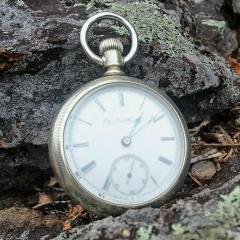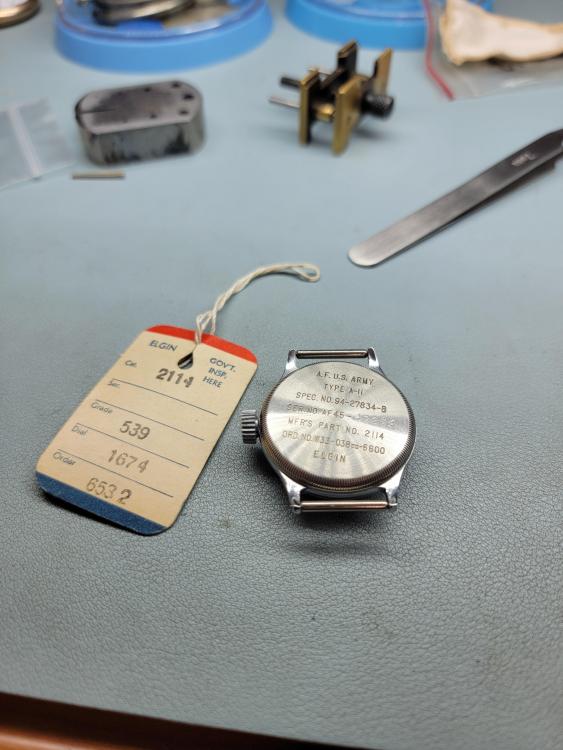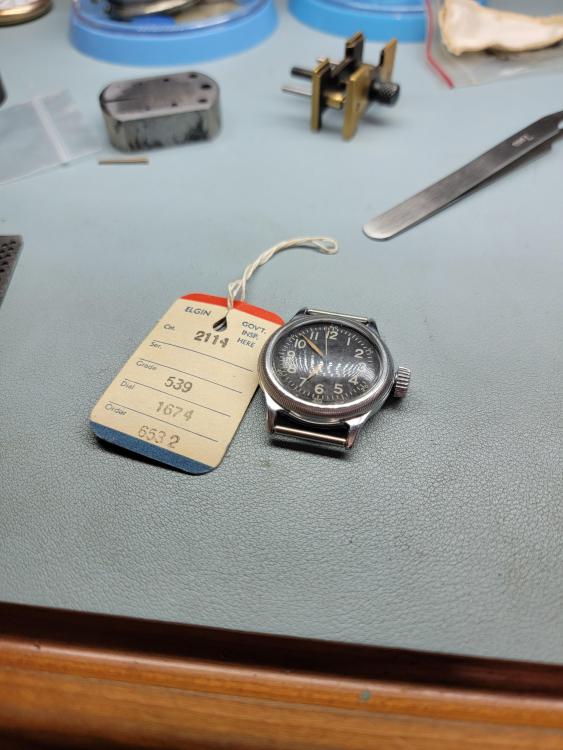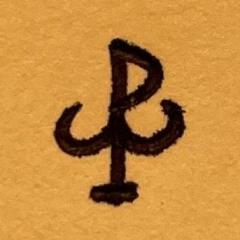Leaderboard
Popular Content
Showing content with the highest reputation on 09/05/22 in all areas
-
2 points
-
Hello Fredrik and welcome to he forum, you have started out on the right path with Marks courses, good luck and all the best.2 points
-
2 points
-
Actually i add a spoonful of coconut oil, it starts the lubrication process and also initiates morning fat burning metabolism1 point
-
Usually you would source a hairspring based on the watch's balance which should have an integral regulator built into the balance cock. If the watch initially had a hairspring with a Breguet over coil, you would want the replacement spring to be the same. This earlier thread from 2018 discusses obtaining a hairspring: https://www.watchrepairtalk.com/topic/8039-obtaining-a-hairspring/ Here are several videos that you might find of interest: Changing a damaged hairspring Repairing a twisted hairspring Repairing a bent hairspring @Murks have you taken any of Mark's online courses? I think you would benefit from taking his course #2 as well as the next one (#3). I thought #3 was of the most benefit to me.1 point
-
@Neverenoughwatches How do you take your watch cleaning solution, with cream and sugar?1 point
-
1 point
-
Hi Step two was to have a mesh base with a trap at the bottom and a filter (coffee filter paper) on top of the mesh to collect the dirt, that way with a second filter the fluid could be re used. These are still in the thinking stage and not been drawn up even, just food for thought.1 point
-
The various methods used over the years by manufacturers to stop the movement for hacking are very interesting. This one puts a brake on the sweep seconds wheel directly, rather than the balance. Based on information from the NAWCC forum regarding the Ball hacking version of the 1604, the stopping lever that hits the sweep second wheel when hacked is present in your watch as well as the spring that acts on it, although the spring isn't placed correctly against the outside surface of the lever. If putting things right with the spring causes the watch to be stopped no matter if the stem is pulled or not, then you may be missing the other needed part, which is "An arm underneath the crown wheel [that] is attached to the lever and to an indent in the sliding pinion". https://mb.nawcc.org/threads/1960s-ball-trainmaster-hacking-a-schild-1604b.182252/1 point
-
I don't use perc, I use the much nastier Trichloroethylene. This is what my original bottle of One-Dip from Troop-Balas Laboratories was made from. The only thing I usually use that for is balance jewels, works pretty well. Pallet forks and balance assemblies go through my regular cleaning cycle. One thing that bedevils me is that my rinse doesn't always dry well, so I sometimes add a quick rinse in Isopropyl alcohol. If I'm not happy with pallet fork jewel cleanliness that will get a dip in the Trich. Something that I've noticed is that harisprings will stick together and not dry, liquid gets between the coils and does not evaporate. Takes a bit of blowing with the puffer to get that sorted. I also have the occasional static problem, ny plastic parts tray will occasionally build up a charge, and I'll find the smallest screws running away from my tweezers when I try to pick them up Cheers!1 point
-
@Gramham This is an effective means of mixing and agitating a fluid. I have even used it for cleaning particulate contamination from oil's. I'll tell you because of your interest in cleaning. Put enough water in the bottom of a container of oil to cover your air stones. The container should have proportions more of a column then of a pan. Since the bubbles are formed in the water and then traverse into the oil, a thin membrane of water still exists. When the bubble pops at the surface the water droplets collect or adhere to particles, pulling them down on the return trip. This is better for organic particulates, as well as others gust above and below what is economically viable to filter. At some point the participants are to small to remove this way and are way to small to filter. The next and best step is gravity settling. Anything not removed by this point is probably a very fine mineral or metallic substance (or fine drop of water) and is denser then the oil. It will sink to the bottom over an extended period of time. That being said, without the trap at the bottom to hold the contamination, I think its addition to mechanical washer might keep more of the finer particles in suspension, not allowing gravity to remove them. If it's your only way of agitation, we do what we need to do but I don't think it's necessary to add to a mechanical cleaner. The proof is in the doing. If you try it, let us know how it works. @watchweasol I have used industrial rotating spray cleaning machines in the past. Your thoughts are intriguing. One of the very best way of degreasing something is physical vapor deposition with condensation recovery. Unfortunately there is no mechanical means of removing any leftover particulates afterwards. I'm wondering if this could be a second step within the same machine. Shane1 point
-
@berniethebolttell me about it i spend alot of time foraging lol. Glad i could help.1 point
-
Hi The attached will probably help you with the terminology as well as provide a bit of useful information. cheers TZIllustratedGlossary.pdf1 point
-
I have toyed with the Idea of spray cleaning, where the parts are static and the fluid is continually sprayed over them using something akin to an air brush set up or similar. Kind of like when cleaning engine parts in a paraffin bath. not done anything with the idea as yet but its one for the future.1 point
-
It's 99.9% perc which is about .5% more pure than one dip was. How long do you do your rinse in the stuff out of curiosity? Oh i just mean the desk itself, the monitors and stuff above it. I dry it well before i get out the tools and those sit on a mat anyways. the part of texas i'm in is insanely dusty, it's a constant battle here! EDIT: @gbyleveldtSo i ran em through the perc again. I'm thinking they might be weakly magnetized, after doing what you said the hairsprings looked better. The new one has coils closer together on one side tho but if you bump or tap either of them coils of the hair spring will just start sticking together again and if you lift up the balance wheel it will unstick them till it gets tapped or bumped again. I dunno, it looks better at least so i guess i'll proceed with reassembly when my auto oiler arrives and see how the amplitude looks once it's all demagnetized... Tbh i'm not even sure how watches get magnetized, I know my laptop does it if i use it with a watch on and I know phones do it. Storing them for weeks near a video game console...probably not a great idea...1 point
-
The best way is to keep a record of your repairs in a book or these days use a database, you can enter all what you have had to do too a watch.1 point
-
Hi all! I've been absolutely fascinated by mechanical watches and all the engineering work behind them ever since I stumbled across Bartosz Ciechanowski's awesome blog back in May. Since then I've watched a number of repair/restoration videos on YouTube and today I finally signed up for Mark Lovick's course. By trade I'm an embedded software developer so I'm excited to embark on this hobby which actually involves using my hands. If that means I'll eventually be able to breathe life into neglected pieces of engineering art, then I'm all for it. Anyway, looks like you have a very well-behaved and helpful community here and I'm happy to become part of it. cheers, Fredrik1 point
-
1 point
-
Hi, I actually use a loupe and a sharpened screwdriver edge to neatly and very small scratch into the inner face of a plate. As with all old marks and marks I’ve come across you really can’t see it unless looking for it or it catches the light. As for Rolex etc having their day that’s up to them what they dictate to their service centres. That’s one of the reasons I turned towards clocks, I pretty self sufficient for spares and repairing/making parts from scratch, no swatch group holding me to ransom1 point
-
Thank you for your introduction and welcome to this friendly forum. We all look forward to your contributions and continued involvement.1 point
-
1 point
-
Heh, the classic “my cleaning solution got contaminated” scenario. Put some fresh solution in a shallow jar, place the balance upside down in it. Then gently lift the balance from the cock while immersed to allow fresh solution to get between the coils. Slight agitation will help. Take the balance out and place upside down again, lift the balance again exposing the HS and gently puff till dry. Install and go have a beer to celebrate1 point
-
Good idea to take the course. I finished the first two and working on the third. That stuff is amazing.1 point
-
is the word quartz found anywhere on the dial or did you make the assumption that it's a quartz clock? usually electric clocks do not run on 9 V batteries because it has such an incredibly short life. by the way this theory is conflicting with the original quartz clock. but I do tend to agree with the theory that it's not quartz I've snipped out a section we need a much much better picture of this. looks like a coil some insulated components no circuitry, sets hidden in the base someplace which also indicates probably not a quartz clock. I'm assuming it says Bulova on the dial but in your pictures I can see hugo hettich?1 point
-
1 point
-
I found this on a site 065-495 Stems to fit 9T13, 9T15, 9T22, 9T33, 9U13, 9U15, B232M, E001M, E011M, E031M, so look on cousins for miyota 065.495. Looks like they have it.1 point
-
Well, thank you one and all for the welcome advice.patience and perseverance won the day! what I learned: check all components under magnification.Take a break! also I didn’t Take into consideration the side shake and end shake engineered into the components when assembling. thanks once again all. tonyg1 point
-
The maker space here has the equipment and I have some cnc experience from a previous life but I have let my membership lapse and their two hours away in each direction. Not to mention that I am not very social. I do not knock those guys in the slightest but if you go there to make something you wind up repeatedly teaching a class, to every person passing by, about why you're doing it the way that you're doing it. Some people really get into doing that... I don't; at least not in person and not to people who are really only interrupting you because they think that's just being polite. It's not that I don't like helping people or explaining myself, it's just when I do it in this format, I rarely get home after midnight. Forty bucks is starting to sound better.1 point
-
Most watch repairs/makers have their own code when it comes to marking the case I doubt very much that it is straight forward. Some are easy, others are like cracking the enigma code.1 point
-
quite often the case Bernie replacement out weighs the repair, sign of the times .0 points















